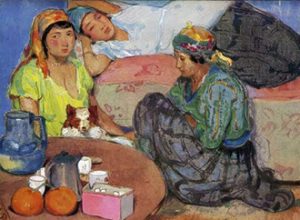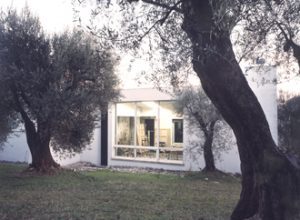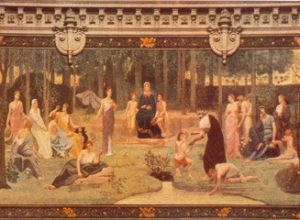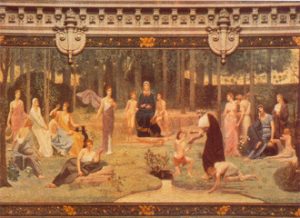
Society is not immune to what Richard Thomson calls a visual culture that in turn plays upon people’s mentalities. In the case of the French Republic between 1889 and 1900, he sees an opportunity to depart from the established categories of art history, which often limits itself to studying avant-gardes while downplaying the notion of the subject. What he discovers in the way of a connection between images and the societal debates is of precious value: there is the decadence of the nation, of the nation’s body; the nagging desire for revenge against Germany (art works showing this much more than literature); the creation of Darwinian representations of the crowd and of the working classes, the dangerous classes; the religious question, at the very moment when the Republic, weakened by the Boulangist crisis and the Dreyfus Affair, had to soften its anticlerical positions; and the emergence and spread of signs of a kind of sexuality whose harshness and crudeness offered a reflection of relations between men and women. None of all that remained alien to art, which was less an illustration than a reservoir of strong sensations and new manners.
With Thomson’s aid, it is not difficult to grasp how wrong it would be for us to treat the world of forms in isolation, sparing it the weight of history. This world does not follow upon political, social, and economic history but acts, rather, in accordance with its own tendencies and rhythms. And while it is affected by the times, it plays just as largely upon its influence over the forward march of societies. The author has broken down the barriers between the various fields of the human sciences in order to arrive at an original history of people’s mentalities. We should be delighted that his book, The Troubled Republic: Visual Culture and Social Change in France, 1889-1900, is to be translated and published in France. Rodolphe Rapetti, renowned for his writings on nineteenth-century art, responds to him after his own fashion, recalling to what extent there exists genre of original art history that revitalizes our view of an apparently already well-known object.
Laurence Bertrand Dorléac
Seminar of May 4th, 2006
Richard ThomsonThe Troubled Republic:
Visual Culture and
Social Change
in France, 1889-1900
What interests me are the ways in which visual culture articulated, shaped, and responded to the dominant mentalités of France in the 1890s. Art historians, certainly in the Anglo-Saxon world, tend to concentrate chiefly on avant-garde art, and this focus on art made by and for the youthful and élite tends to ignore the very varied kinds of art that reached out to the wider couches sociales. Historians, on the other hand, are often uncomfortable dealing with imagery, and shy away from exploring how it intersects with their concerns. If we take visual culture to mean the widest variety of forms of representation – not just avant-garde art but public sculpture and decorations, posters, Salon painting, caricature, children’s illustrations, photography, etc. – how can it illuminate our understanding of mentalités ? In my book The Troubled Republic (Yale, 2004), I try to explore this by examining the interplay between imagery and four specific social debates[ref]Richard Thomson, The Troubled Republic. Visual Culture and Social Debate in France, 1889-1900. Yale University Press, 2004.[/ref] Was France in a state of moral and physical degeneration? Was ordered society at threat from the populations now massed in modern cities? Did religion have a role under the Third Republic? Could France ever reclaim Alsace-Lorrain?
Certain consistencies formed a context. Although France in the 1890s was fractious, with its series of short-lived governments, the threat of Boulangism, and the deep divisions exposed by l’Affaire Dreyfus, the Republic remained the consensual centre. Imagery was one of the means by which the regime sought to reinforce its ideological position. Implicit in many of the paintings exhibited at the Salons and purchased by the state are the values of liberté, égalité and fraternité, as we shall see. The Republic also laid great emphasis on its credentials as a progressive regime, free of hierarchy, superstition and cumbersome tradition and open to progressive new ideas. Increasingly scientific ideas were becoming current in popular thinking. The Eiffel Tower, centrepiece of the 1889 Exposition Universelle, was a symbol of France’s technological prowess and progressive ambitions. Charles Darwin’s ideas about evolution and degeneration, first published in 1859, had thirty years later entered public consciousness. For example, the journalist Jules Huret’s 1891 enquête on the state of French literature was based on the idea of a ‘struggle’ between naturalism and symbolism, a literary survival of the fittest. Darwinian ideas were also common in the ways in which society and indeed nations were understood to operate. Quite another branch of science had also infiltrated the public mind. La psychologie nouvelle of Jean-Martin Charcot and Hippolyte Bernheim had begun to explore the workings of the inner mind. The idea that individuals and even social groups were subject to suggestion derived from their work, and terms derived from psychology such as surmenage and neurasthénie slipped into everyday parlance and understanding of how people behave in the modern world. Thus in various forms scientific ideas shaped the interpretation of social patterns. In addition, a sense of the increasing pace of life caused anxiety. The 1890s saw the spread of modern technologies such as the telephone, the lift, the bicycle and the motor car, all of which made life seem faster and less stable.
A Degenerating Nation?

Puvis de Chavanne, La Sorbonne, (detail showing central section), completed 1889, Paris, Grand Amphithéâtre de la Sorbonne.
The first debate my book considers is the idea of degeneration. The opposite of the Darwinian notion of evolution, degeneration was a physical and moral problem which could be diagnosed, so it was commonly held, in the national and in the individual body. Degeneration was widely debated by commentators such as Max Nordau and Alfred Fouillée.[ref]Max Nordau, Entartung (Dégénérescence), Berlin, 1892 ; Alfred Fouillée, ‘Dégénérescence ? Le passé et le present de notre race’, Revue des deux mondes, LXV, 15 October 1895, pp. 793-824.[/ref] Rising levels of alcoholism and venereal diseases, a stagnant birth rate and surmenage were all seen as symptoms. The birth rate was a particular problem, and in the half-decade between 1891 and 1895 deaths actually exceeded births in France by three hundred. Visual culture played its part in efforts to counter-act this. This is not surprising: the debate about degeneration revolved around the body, and the body was the raw material of the artist. In 1894 Pierre de Coubertin, with his campaign rebronzer la France, launched the modern Olympic movement at the Sorbonne, in front of Puvis de Chavannes’s mural, Puvis being an artist whose classicism was understood to be healthy and untarnished with notions of degeneration. Paintings were used to promote physical fitness, as we see in an image such as L’Inspection générale des exercices physiques au Prytanée militaire by Charles Crès (1889). They were also used to record and approve other manifestation of public health. Jean Geoffroy’s triptych of 1903 celebrated Dr. Gaston Variot’s La Goutte de Lait clinic in Belleville, where working-class women were instructed in modern, hygienic methods of child-care. Such images promoted republican values: democratic, egalitarian, progressive and scientific. If such examples shored up notions of virility and maternity, other imagery played with ideas of decadence. Artists such as Edger Degas and Pierre Bonnard explored specifically sexual imagery, perhaps with an increased consciousness of fantasy and psychology in their representation. In 1888 Degas exhibited a number of pastels at the Galerie Boussod et Valadon. Among them was a drawing of a kneeling female figure which is overt in its sexual actuality, and it is surprising that at that date an artist should be prepared to exhibit publicly a work which is so revelatory of his erotic desires. A painting such as Bonnard’s L’Homme et la femme (1900) may well be best understood as self-analysis of the artist’s own psycho-sexual behaviour. It belongs to a group of works made around 1899-1900. They follow an earlier group which with their brighter tones seem to celebrate his sexual relationship with his mistress Marthe, whereas these later paintings, dark and divisive, suggest that Bonnard was examining his role in this partnership with a bleaker eye. Another common theme with artists was the representation of adultery, at once a commonplace of caricature and boulevard theatre but also feared as a symptom of social decadence. The most precarious moments of intimate human experience were presented often as comic diversions, and as pessimistic diagnoses of the condition of national behaviour and morality.
Theorising the Crowd
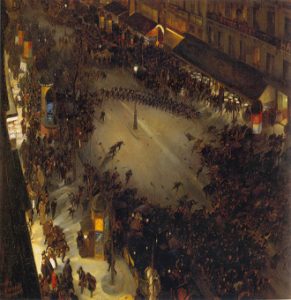
André Devambez, La Charge (The Charge), 1902, Paris, Musée d’Orsay.
A second debate concerned the crowd. Given that France had had mass public insurrections in 1830, 1848 and 1871, it was feared that the cycle would repeat itself around 1890. Although the regime was not changed by the force of the crowd during tis period, the Republic was troubled by mass demonstrations, from the height of Boulangism in 1888-9 to the attempted coup d’état by Paul Déroulède and the Ligue des Patriotes in 1898. The Republic feared the crowd motivated by its enemies on either flank, nationalists on the right and socialists on the left. If dangerous crowds such as those needed to be prevented or at least controlled, there were also more positive crowds, such as the 32 million visitors to the 1889 Exposition Universelle, whose impulses also could be controlled, to the benefit of the regime. Intellectuals from different backgrounds applied themselves to understanding the functioning of crowds. Perhaps the most important of these was Gustave LeBon. His La Psychologie des foules used medical and Darwinian concepts to understand the crowd, which he interpreted as suggestible, female, and dangerous unless manipulated to positive ends.[ref]Gustave LeBon, La Psychologie des foules, Paris, 1895[/ref] For LeBon, ideas infected crowds like a contagion or epidemic, forming the mass of people into a single organism. Such ideas about crowds quickly entered the cultural mainstream. Emile Zola’s novel La Débâcle, published prior to LeBon’s book in 1892 and describing the crowds of the Franco-Prussian War and the Commune, does not use the word contagion, but it is a key concept in his Paris of 1898. The pictorial representation of crowds at this time also follows such assumptions. Jean Béraud’s crowds at the 1889 Exposition Universelle are ‘good’ crowds enthused by a unifying positive idea, whereas Paul Buffet’s scene from Salambô (1894) represents an army, thus an organised crowd that in extremis has degenerated back to barbarity and cannibalism. It was understood that the crowd’s instincts needed to be controlled, either by systems such as the army or by positive ideas and rituals such as the Bastille Day parade. Paintings such as Louis Loustaunau’s Présentation de l’étendard aux recrues (1892) or mass circulation photographs of quatorze juillet celebrations were presented to different audiences, but all such imagery was intended to exemplify respectful and appropriately directed mass social behaviour. Failure to control the crowd led to the social disruption represented in André Devambez’s La Charge (1902), in which the forces of order form a harmonious shape in contrast to the darkness and chaos of the rioters. Although it would be over-insistent to argue that artists of very different kinds followed or even were aware of the specific ideas of LeBon, analysis of images of the French crowd in the 1890s suggests that there was an informal consensus around the generality of ideas that such theorists put about, ideas that were filtered through to public consciousness through media such as the newspapers and novels such as Zola’s.
Religion and the Republic
The third debate is the issue of religion. The Third Republic was based on laïque principles. However, by 1890 circumstances began to force Church and state together. Threatened by Boulangist nationalism, centrist republicanism needed to consolidate its power base, and a softening of its anti-clerical position could help this. For his part, the Pope, Leo XIII, recognised that the Republic was now permanent, and sought it as an ally against socialism. The Papal encyclical Au milieu des solicitudes of 1891 accepted the validity of the Republic, and encouraged French Catholics to rally to it. Although the Ralliement was ultimately a political failure, it did lead to a widespread reconsideration of people’s positions vis-à-vis belief. There was art that was catholique avant tout, whether it was the naturalism favoured by many church decorators or the more progressive solutions of Maurice Denis or Charles Dulac. Denis’s La Glorification de la Sainte Croix, painted for the church of Sainte Marguerite at Le Vésinet, combined modern chromatics with a simplified style derived from his study of Fra Angelico, the combination suggesting the continuity of Christian belief. If Denis’s Catholicism was obviously central to his work, at times it is not easy to account for an artist’s position. Léon Lhermitte’s Sainte-Claire-Deville (1890), painted for the Ecole de Chimie, appears like a celebration of a modern man of science yet adopts the compositional format of a Last Supper. So too does Charles Cottet’s triptych Les Adieux (1898), its quietism and acceptance of suffering appropriate for an artist educated by the Marians. Other artists took up explicitly anti-clerical positions. For example, Jean-Paul Laurens’s St. Jean Chrysosthome et l’Impératrice Eudoxie (1893) uses a scene from Byzantine history to criticise the interference of the Church in the affairs of the state. Catholic artists also tried to modernise their imagery. In 1890 the Dominicans had set up l’Ecole Biblique in Jerusalem, using the scientific techniques of archaeology to fortify their reading of Biblical truth. Their support underpinned James Tissot’s of La Vie de Notre Seigneur Jésus Christ (1896), with its extraordinary verism. Ce que notre Seigneur a vu de la Croix is bizarre and almost blasphemous in its desire to recreate what Christ saw just before its death. If this was Catholic art carried to an extreme, in other cases Catholic artists responded more moderately. Etienne Moreau-Nélaton, for example, seems to have allied himself to the Social Catholicism of Albert de Mun, his poster supporting the construction of Notre-Dame du Travail a pious act on the part of a privileged man to support the ordinary man and keep him allied to the Chruch rather than to socialism. Thus although artists took various positions over the imagery of belief during this period, and at times it is not easy to establish exactly their position over such private matters, it is clear that religious issues preoccupied many artists. The variety of their imagery is indicative of the complexity of such issues during the 1890s.
Revanche or Regret
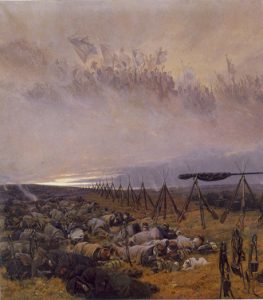
Edouard Detaille, Le Rêve (The Dream), 1888, Paris, Musée d’Orsay.
The fourth debate is particularly interesting because historians tend to consider that during the 1890s the issue of revanche against Germany to recover the lost provinces was dormant. While this may have been true in political, diplomatic and military terms, revanche remained active in the popular mentalité, as its prevalence in visual culture affirms. The point is that imagery could operate at several levels. Images of the army, such as Eugène Chaperon’s Le Photographe au regiment (1899) conveyed suitably republican values about the égalité and fraternité of conscription, without being revanchard. Other images could be more aggressive, from a collector’s print like Félix Bracquemond’s Vive le Tsar! (1893), which celebrates the alliance Franco-Russe, to Jean Veber’s extraordinary Boucherie, expelled from the 1897 SNBA at the request of the German embassy because the butcher with his shop of human meat resembles Bismarck. Other work was more allusive. Le Rhin, the table made by Emile Gallé and Victor Prouvé for the 1889 Exposition Universelle, shows the Gauls and the Teutons divided by the great river, with a quotation from Tacitus claiming that this is the natural order of things. Equally allusive was Puvis’s mural of Geneviève ravitaillant Paris (1893-8) for the Panthéon, in which a scene from the 5th century carries with it association of the 1870-1 Siege of Paris. One problem in the third decade after the Franco-Prussian War was how to keep memory alive. Scenes from the War were often reproduced in prints and photographs for wide circulation, as was the case with Alphonse de Neuville’s Les Dernières Cartouches (1873), or the quasi-allegorical icon Elle attend by Henner (1871). It was also important to keep militaristic ideas in front of children, especially boys who would form the armies of the future. A poster for a department store in Bordeaux (1899) typifies this, and Geoffroy’s Nous les aurons! uses Jeanne d’Arc’s famous patriotic cry in an image of modern boys playing soldierly games. Imagery was various in its forms and could be read in various ways. A painting such as Ernest-Jean Delahaye’s Montbéliard: Paul Déroulède entre le premier dans la ville (1899) is a propaganda image for its nationalist hero, whereas Pascal Dagnan-Bouveret’s Les Conscrits (1889) is a generic image of young Frenchmen going to do their duty for the nation. Edouard Detaille’s Le Rêve (1888) links the sleeping French army in fraternité while they dream of the gloire of their recent military antecedents as the day of battle dawns. Their enemy is not identified, allowing for ambiguity. In a war memorial such as Edouard Lormier’s Mort pour la patrie (exh. 1898) the realistic representation of the battlefield is given added immediacy by the figure of La France who bursts out towards the spectator. Paintings and monuments such as these could be interpreted in different ways, according to ideology or the politics of the moment. While they could be read as passive, images of memory or collective values, they could equally be read as cries for an incipient war of revanche. This ambiguity and flexibility was potent, and in visual culture the idea of revanche was far from dormant.
What I have tried to suggest in this summary of my book are the broad outlines of my arguments. The book is founded on several principles. One is that to understand the visual culture of the period we have to look beyond the art of the avant-garde to art that was made by and for the mass of the bourgeoisie and the people. This is inevitably imagery in all kinds of media, from the grandest to the most trivial. The second is that the analysis of visual culture is a very rich method of understanding dominant and conflicting mentalités. Imagery, in all its variety, was not a passive repository of ideas, opinions and prejudices. Rather, it was a dynamic force, a means of moulding, articulating and stimulating the public mind. The third principle stems from this. Such a study stands at the intersection of history and the history of art, and that crossroads is a very rich place at which to work.
Richard Thomson is the Watson Gordon Professor of Fine Art at the University of Edinburgh, a post he has held since 1996. He is the author of Seurat (1985); Degas: Les Nus (1988); Edgar Degas: L’Attente (1995); and The Troubled Republic: Visual Culture and Social Change in France, 1889-1900 (2004). He has been the curator or co-curator of a number of exhibitions, including “Toulouse-Lautrec” (Hayward Gallery, London, and Grand Palais, Paris, 1991-1992), “Theo van Gogh” (Van Gogh Museum, Amsterdam, and the Musée d’Orsay, Paris, 1999-2000), “Monet, 1878-1883: The Seine and the Sea” (National Gallery of Scotland, Edinburgh, 2003), “Toulouse-Lautrec and Montmartre” (National Gallery of Art, Washington, and the Art Institute of Chicago, 2005), and “Degas, Sickert, Toulouse-Lautrec: London and Paris, 1870-1910″ (Tate Britain, London, and Phillips Collection, Washington, 2005-2006).
